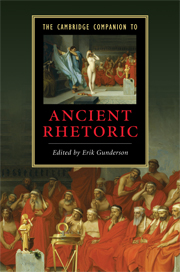Book contents
- Frontmatter
- Introduction
- Part 1 An archaeology of rhetoric
- Part II The field of language
- Part III The practice of rhetoric
- Part IV Epilogoues
- 14 Rhetorical practice and performance in early Christianity
- 15 Rediscoveries of classical rhetoric
- 16 The runaround: a volume retrospect on ancient rhetorics
- Appendix 1: Rhetorical terms
- Appendix 2: Authors and prominent individuals
- References
- Index of passages
- Index of subjects
- Series list
14 - Rhetorical practice and performance in early Christianity
from Part IV - Epilogoues
Published online by Cambridge University Press: 28 January 2010
- Frontmatter
- Introduction
- Part 1 An archaeology of rhetoric
- Part II The field of language
- Part III The practice of rhetoric
- Part IV Epilogoues
- 14 Rhetorical practice and performance in early Christianity
- 15 Rediscoveries of classical rhetoric
- 16 The runaround: a volume retrospect on ancient rhetorics
- Appendix 1: Rhetorical terms
- Appendix 2: Authors and prominent individuals
- References
- Index of passages
- Index of subjects
- Series list
Summary
According to the Gospel of Luke (4:16-20), Jesus of Nazareth inaugurates his mission in his hometown by entering the synagogue on the Sabbath and reading a passage from the prophet Isaiah (Isaiah 61:1-2). In this story Jesus not only reads from the scroll of Isaiah, declaring that this particular prophecy has now been fulfilled, but also goes on to offer an interpretation of the meaning of that text (Luke 4:23-30). In Luke’s second book, the Acts of the Apostles, Paul similarly visits a synagogue on the Sabbath (Acts 13:14-43). He is asked to deliver an exhortation or “word of encouragement” (logos paraklēseōs) after the reading from the “law and the prophets.” Here, in Pisidian Antioch, Paul proceeds to offer one of the more extensive examples of early Christian “missionary preaching,” designed to win his primarily Jewish audience over to the “gospel of Christ.” These two narratives provide intriguing glimpses, if not so much into the actual preaching of Jesus or Paul, at the very least into the character of the preaching that ostensibly predominated in early Christian practice, identity construction, and historical remembrance. Even more so, these two narratives indicate the complexity of early Christian rhetoric insofar as the performance of oratory appears already to have been bound up with both Jewish Scripture/tradition and the development of Christian narrative.
The “character” of early Christian oratorical discourse
One of the formative perceptions, in large part generated by images offered up by early Christian literature itself, is that missionary preaching and community teaching grounded the burgeoning first- and second-century Christian movement. A significant part of this picture comes from reading the Acts of the Apostles in conjunction with the letters of the New Testament. The question looms large, however, whether these bodies of literature allow us to reconstruct actual early Christian practices or if they should rather be interpreted as ideal and secondary representations of these practices.
- Type
- Chapter
- Information
- The Cambridge Companion to Ancient Rhetoric , pp. 245 - 260Publisher: Cambridge University PressPrint publication year: 2009
- 2
- Cited by



